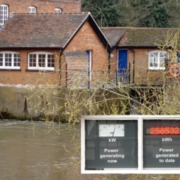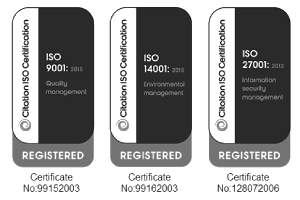Ten years at Guildford’s Hydro-electric plant
Chris Reynolds, from Guildford Borough Council, discusses how the local authority was able to create a hydro-electric plant from a derelict mill, enabling them to generate their own renewable energy.
It is now ten years since Guildford Borough Council reopened a derelict mill site on the river Wey with a new hydro-electric turbine. The project has proved highly successful and the turbine continues to generate sufficient electricity to power approximately fifty homes. In ten years of operation, the plant has generated over 1.5GWh of electricity which spills directly to the grid.
This original mill building, located close to the centre of Guildford, was constructed in 1896 and specifically to house a water turbine which pumped water to the town’s reservoir on Pewley Down. The original mill ceased working in 1952 when electric pumps took over and the building became derelict. The Guildford Hydro Project involved refurbishment of the building and replacement of the water turbine which now drives an electricity generator.
Ten years ago the project cost £340,000 of which about £100,000 was needed to restore the listed building. The Council has gained a consistent income from the exported power, and has made use of a historic building that would have still required upkeep. Overall it is considered that the original objectives have been successfully met and the payback is close to the original projections. However, community value has also been gained from the project. The Town Mill regularly hosts guided tours both by Council staff and the National Trust, and a river trip by the National Trust now includes a tour of the hydro plant. It has become a feature of Guildford, striking a balance between a heritage site and a forward-looking facility with a very modern purpose. What’s more, we have been able to bring about additional community benefits, for instance it is used for school visits for year 5 and 6 pupils. These tours include a drama workshop by the local youth theatre, a tour of the plant, and a lesson on other aspects of energy such as energy efficiency.
Guildford conducted a Renewable Mapping Exercise in 2014-15. The results of this exercise confirms the importance of the river as Guildford’s best opportunity to harvest heat and power from renewable sources. We typically have low wind speeds and significant other constraints on wind and large scale solar energy, however the river provides a continuous flow of potential energy and heat. The exercise has helped us understand exactly where the opportunities for renewable energy in the borough are. This will enable us to be much more effective at deploying, or encouraging the deployment of, renewable energy generation in places where it is most suitable, and with the technologies that will be most effective. Guildford has a very high proportion of the borough subject to planning constraints, for example green belt and areas of outstanding natural beauty, and the mapping exercise enabled us to create some form of hierarchy of constraint, and to see the need to use appropriate technologies in these areas.
The heat mapping part of the exercise has been especially important. It has helped us to encourage heat networking in those areas that will be viable – an important aspect of future proofing the borough. Again, this will enable the council to better understand the opportunities to save carbon in heat provision, and for planners to guide developers along this route only in areas where it has already been identified to be appropriate.
In terms of the mill itself, the original turbine, a 42” Francis open flume type, had been manufactured by a company called Gilkes and was not in a good enough condition to be operated. However, an identical model was found in a field in Ireland and after some repair was installed along with the gearbox and generator. It is a reaction turbine which runs full of water and creates pressure differences across the blades to extract energy from the available head of water (the difference between the upstream and downstream water levels). The turbine is unusual as it rotates in a horizontal plane and at a low speed of approximately 75 rpm. The turbine is rated at 68 HP at a 6 ft/1.8m head of water.
The turbine spins over what is effectively a plughole in the bottom of the upstream river leading to the lower level. The louvres around the outside of the impeller are operated through linkages by a hydraulic ram. They accurately control the flow of water passing through the impeller.
The entire system is controlled by an electronic unit which constantly monitors the upstream water level. It is connected to a sensor which is set to a specific working water level. If the sensor detects a high level it knows that the flow entering the river upstream is greater than that passing through the turbine and it will instruct the hydraulics to open the louvres by a small amount. This allows more water to pass through the turbine. This procedure continues until the two flows match each other and the level then remains constant. Similarly, if the flow upstream decreases, for instance after a storm surge or the opening of another sluice gate to the lower level, then the sensor will detect a low level and will gradually close the louvres until the flows match. The system is therefore constantly adjusting to the maximum it can generate from the available flow.
Under optimum conditions the generator will provide 45 kW and, because of the nature of hydro-electric power and the constantly adjusting equipment, this can be expected to produce continuously. The original target was to generate 260,000 kWh per year. The River Wey is a navigable river and we typically find lower yields during the summer when the river is managed to best retain water upstream for other river uses. The hydro also turns off if water flow is too high, and this occurs more often in winter during flood conditions. In December 2013, flood conditions in Guildford were so bad that the turbine housing and some other equipment needed to be rebuilt. The damage was largely caused by the amount of gravel and stones being washed downstream from the river towpaths. This resulted in a period of in-operation as rebuilding could only take place outside of bat breeding periods.
In the future, it is hoped that the hydro plant can be replicated at other suitable locations along the river, allowing Guildford to replicate this success and further develop its renewable energy sources.


.png)



.png)